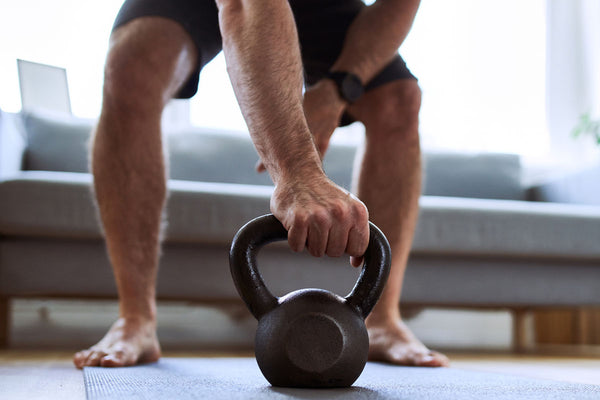Barefoot training has become increasingly popular in recent years and for good reason. Not only does it introduce a new challenge for your workouts (which helps to avoid plateaus), but it also offers a variety of benefits that traditional shoe-based workouts don't.
In this article, we’ll explore some of the key benefits of barefoot training, as well as some exercises and precautions to keep in mind when incorporating barefoot training into your weekly exercise program.
Let’s start with the basics…
What is Barefoot Training?
This is pretty simple to grasp.
Barefoot training is performing your normal workout routine with bare feet (aka not wearing shoes).
Naturally, you’re wondering, “why would I train barefoot?” or “what are the benefits of barefoot training?”
Top 5 Benefits of Barefoot Training
Strong Feet & Ankles
Kids are always asking to take their shoes off and run around. As we get older we have an aversion to going barefoot outdoors (and even indoors sometimes). In certain situations (such as dining out or walking down Bourbon Street), but wearing shoes all the time has a big drawback -- it can weaken the muscles in your feet and ankles, and even lead to collapsed arches.
Barefoot training, however, can help you build strength and endurance in these areas, which can help improve your overall athletic performance while also reducing your risk of injury. In fact, research demonstrates that training with minimalist shoes (the next best thing to barefoot training) improved foot strength and performance.[1]
Increased Balance & Stability
Working out barefoot forces you to rely on the strength and stability of your feet and ankles. This can help improve your total-body balance and stability, which is especially useful for combat athletes, dancers, and other individuals who participate in fast-twitch sports which rapid changes in direction.
Increased Resistance to Injury
Strengthening the muscles in the feet and ankles helps to improve balance and coordination, which can reduce your risk of injury. With this in mind, barefoot training can reduce the risk of common foot and ankle injuries, such as sprains and strains.
Greater Proprioception
Proprioception is your sense of self-movement, force, and body position, especially understanding how your body moves through space.
Wearing shoes all the time disconnects you from the ground, which means that you start to lose a sense of connection with your surroundings. Barefoot training, on the other hand, allows you to feel every movement and have greater kinesthetic awareness, which improves your overall balance, coordination, and performance.
Encourages Better Posture
Modern living affords us countless conveniences and benefits. At the same time, we spend an increasing amount of time being sedentary and hunched in front of screens (TVs, computers, smartphones, etc.). This leads to poor posture and muscle imbalances.
Barefoot training can also help improve your posture by forcing you to engage your core muscles and stand up straight.
How to Get Started with Barefoot Training (and Some Precautions)
As with any new fitness endeavor or lifestyle change, slow and steady is the key. If you’ve never trained barefoot, your feet and ankles aren’t used to the additional stresses of training barefoot, which means it wouldn’t be wise to adopt a “zero shoe” policy.
Just as you would with a new exercise program, gradually increase the intensity and duration of your barefoot training workouts. This will help you avoid injury and allow your muscles and joints to adapt to the new demands of barefoot training (as well as help to limit the amount of soreness you get in your foot and ankle muscles).
Also, be mindful of walking and training surfaces. Walking or training on carpet, mats, and/or hardwood floors is very different from walking on concrete or gravel. The latter of which can increase the risk of foot/ankle injuries. Be especially careful when venturing onto surfaces that are hot and uneven, such as sand, asphalt, gravel driveways, etc.
Barefoot Training Exercises
The best way to get started with barefoot training is to simply start walking barefoot, either in your house or apartment or your backyard, but that’s not all.
Barefoot training can also be applied to yoga, pilates, plyometrics, and strength training -- you’ll have a newfound sense of body awareness and force production (“strength & power”) when squatting and deadlift in bare feet (or socks, if your gym has a no bare feet policy). Heck, you can even do your upper body exercises (push ups, dips, pull ups, inverted rows, and overhead presses) with bare feet, though the only real benefit is that you’ll weigh a few less ounces (maybe up to a pound or two), which can help you to bang out a few extra reps.
The Bottom Line on Barefoot Training
Barefoot training helps to strengthen the muscles in your feet and ankles which helps to improve your resiliency, balance, coordination, and sense of movement. It’s best to start slow and gradually increase the amount of barefoot training you engage in, if it’s been some time since you’ve trained barefoot.
For any other questions about training, nutrition, or supplements, feel free to reach out! We’re always here to help you get the best results possible.
When you sign up for the 1UP Fitness App, you can get FREE customized training and nutrition plans tailored to your goals and preferences. You’ll also get access to our exclusive Facebook group where you can get advice and suggestions from experienced coaches and other goal-oriented individuals.
References
- Joel T. Fuller, Dominic Thewlis, Margarita D. Tsiros, Nicholas A. T. Brown, Joseph Hamill & Jonathan D. Buckley (2019) Longer-term effects of minimalist shoes on running performance, strength and bone density: A 20-week follow-up study*, European Journal of Sport Science, 19:3, 402-412, DOI: 10.1080/17461391.2018.1505958






